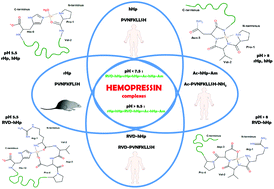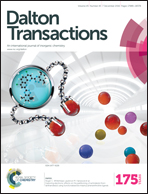DOES hemopressin bind metal ions in vivo?†
Abstract
Hemopressin is a neuropeptide, derived from the degradation of the α(1)-chain of hemoglobin, and possesses several pharmacologic properties, such as the ability to block cannabinoid CB1 receptor activity, to cause dose-dependent hypotension and to inhibit food intake. Actually, human hemopressin (PVNFKLLSH) is only the precursor of a class of longer peptides, called “Pepcans”, which bear additional residues at their amino-terminus and possess slightly different chemical and biological properties with respect to hemopressin. The presence of a histidyl residue and the free terminal amine imparts to hemopressin and its derivatives good binding properties towards transition metal ions. In this paper, we present a wide investigation on the complex-formation equilibria of human hemopressin and three analogues towards the Cu(II) and Ni(II) ions. The study showed that the main coordination site is always the amino terminus (if not protected), while the C-terminal histidine acts only as an anchoring site for the metal ions at acidic pH, with the formation of a macrochelate complex. The presence of additional residues in N-terminal position produces significant differences in the protonation and complex-formation behaviors of these peptides, which can be explained in terms of charge of the ligand and coordination environment. Although the participation of metal ions in the biological activity of hemopressin and Pepcans has not yet been demonstrated, the data reported here can help to shed light on the mechanisms governing the action of these neuropeptides in vivo.



 Please wait while we load your content...
Please wait while we load your content...